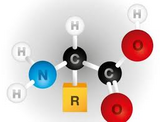
This is about amino acids
- Subject:
- Life Science
- Material Type:
- Module
- Author:
- Mini ML
- Date Added:
- 08/25/2019

This is about amino acids

Students act as if they are biological engineers following the steps of the engineering design process to design and create protein models to replace the defective proteins in a child’s body. Jumping off from a basic understanding of DNA and its transcription and translation processes, students learn about the many different proteins types and what happens if protein mutations occur. Then they focus on structural, transport and defense proteins during three challenges posed by the R&D; bio-engineering hypothetical scenario. Using common classroom supplies such as paper, tape and craft sticks, student pairs design, sketch, build, test and improve their own protein models to meet specific functional requirements: to strengthen bones (collagen), to capture oxygen molecules (hemoglobin) and to capture bacteria (antibody). By designing and testing physical models to accomplish certain functional requirements, students come to understand the relationship between protein structure and function. They graph and analyze the class data, then share and compare results across all teams to determine which models were the most successful. Includes a quiz, three worksheets and a reference sheet.
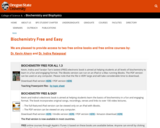
We are happy to welcome you to our second Open Educational Resource (OER) textbook, Biochemistry Free For All. Biochemistry is a relatively young science, but its rate of growth has been truly impressive. The rapid pace of discoveries, which shows no sign of slowing, is reflected in the steady increase in the size of biochemistry textbooks. Growing faster than the size of biochemistry books have been the skyrocketing costs of higher education and the even faster rising costs of college textbooks. These unfortunate realities have created a situation where the costs of going to college are beyond the means of increasing numbers of students.

This resource is a video abstract of a research paper created by Research Square on behalf of its authors. It provides a synopsis that's easy to understand, and can be used to introduce the topics it covers to students, researchers, and the general public. The video's transcript is also provided in full, with a portion provided below for preview:
"The skin micro-environment varies across the body. But one thing that remains constant is the presence of microorganisms that affect skin health. In a recent study, researchers gathered more than 800 organisms from 3 body sites of 17 individuals. Analyses revealed 30+ bacterial genera and 14+ fungal genera, with the most prevalent being Staphylococcus and Micrococcus bacteria. Further tests showed that the collected microbes had the capacity to break down a variety of compounds. including amino acids, steroids, lipids, and sugars, as well as compounds derived from personal care products. This collection of micro-organisms represents a valuable resource for skin microbiome research, with the potential for developing novel therapeutics and for gaining insight into the metabolic activities of the skin microbiota..."
The rest of the transcript, along with a link to the research itself, is available on the resource itself.
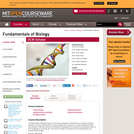
Fundamentals of Biology focuses on the basic principles of biochemistry, molecular biology, genetics, and recombinant DNA. These principles are necessary to understanding the basic mechanisms of life and anchor the biological knowledge that is required to understand many of the challenges in everyday life, from human health and disease to loss of biodiversity and environmental quality.
Course Format
This course has been designed for independent study. It consists of four units, one for each topic. The units can be used individually or in combination. The materials for each unit include:
Lecture Videos by MIT faculty.
Learning activities, including Interactive Concept Quizzes, designed to reinforce main concepts from lectures.
Problem Sets you do on your own and check your answers against the Solutions when you’re done.
Problem Solving Video help sessions taught by experienced MIT Teaching Assistants.
Lists of important Terms and Definitions.
Suggested Topics and Links for further study.
Exams with Solution Keys.
Content Development
Eric Lander
Robert Weinberg
Tyler Jacks
Hazel Sive
Graham Walker
Sallie Chisholm
Dr. Michelle Mischke

The MIT Biology Department core courses, 7.012, 7.013, and 7.014, all cover the same core material, which includes the fundamental principles of biochemistry, genetics, molecular biology, and cell biology. Biological function at the molecular level is particularly emphasized and covers the structure and regulation of genes, as well as, the structure and synthesis of proteins, how these molecules are integrated into cells, and how these cells are integrated into multicellular systems and organisms. In addition, each version of the subject has its own distinctive material.
7.012 focuses on the exploration of current research in cell biology, immunology, neurobiology, genomics, and molecular medicine.
Acknowledgments
The study materials, problem sets, and quiz materials used during Fall 2004 for 7.012 include contributions from past instructors, teaching assistants, and other members of the MIT Biology Department affiliated with course #7.012. Since the following works have evolved over a period of many years, no single source can be attributed.

Amino acids and the central dogma of molecular biology. Amino and carboxyl groups, side chains, and zwitterions.

Introduction to proteins as polymers of amino acids (monomers).

The MIT Biology Department core Introductory Biology courses, 7.012, 7.013, 7.014, 7.015, and 7.016 all cover the same core material, which includes the fundamental principles of biochemistry, genetics, molecular biology, and cell biology. The focus of 7.013 is on genomic approaches to human biology, including neuroscience, development, immunology, tissue repair and stem cells, tissue engineering, and infectious and inherited diseases, including cancer.

The MIT Biology Department core courses, 7.012, 7.013, and 7.014, all cover the same core material, which includes the fundamental principles of biochemistry, genetics, molecular biology, and cell biology. Biological function at the molecular level is particularly emphasized and covers the structure and regulation of genes, as well as, the structure and synthesis of proteins, how these molecules are integrated into cells, and how these cells are integrated into multicellular systems and organisms. In addition, each version of the subject has its own distinctive material.
7.014 focuses on the application of these fundamental principles, toward an understanding of microorganisms as geochemical agents responsible for the evolution and renewal of the biosphere and of their role in human health and disease.
Acknowledgements
The study materials, problem sets, and quiz materials used during Spring 2005 for 7.014 include contributions from past instructors, teaching assistants, and other members of the MIT Biology Department affiliated with course 7.014. Since the following works have evolved over a period of many years, no single source can be attributed.

The MIT Biology Department core courses, 7.012, 7.013, and 7.014, all cover the same core material, which includes the fundamental principles of biochemistry, genetics, molecular biology, and cell biology. 7.013 focuses on the application of the fundamental principles toward an understanding of human biology. Topics include genetics, cell biology, molecular biology, disease (infectious agents, inherited diseases and cancer), developmental biology, neurobiology and evolution.
Biological function at the molecular level is particularly emphasized in all courses and covers the structure and regulation of genes, as well as, the structure and synthesis of proteins, how these molecules are integrated into cells, and how these cells are integrated into multicellular systems and organisms. In addition, each version of the subject has its own distinctive material.
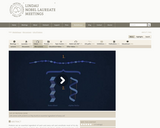
Proteins are an essential ingredient of each and every cell and constitute most of its dry mass. This Mini Lecture explores the chemical structures of the macromolecules and introduces to the specific, three-dimensional constitution of the amino-acid-chain, the buildup and degradation of proteins with lecture snippets of Nobel Laureates Christian Anfinsen and Johann Deisenhofer.

This resource is a video abstract of a research paper created by Research Square on behalf of its authors. It provides a synopsis that's easy to understand, and can be used to introduce the topics it covers to students, researchers, and the general public. The video's transcript is also provided in full, with a portion provided below for preview:
"Notch signaling is the key to many binary decisions metazoan cells make during development. Downstream signals from Notch trigger transcriptional remodeling that resolves dichotomies like differentiation between developmental cell fates. In the "Notch on" state, the Notch intracellular domain (NICD) relocates to the nucleus and binds to the protein RBPJ. While Notch activation is well studied, the transition to the "Notch off" state, where NICD and RBPJ dissociate, is not well understood. Recent research using phylogenetic analysis, computational biochemistry, and in vitro experiments suggests that heat flux is an important regulator of Notch signaling. The researchers determined that NICD senses temperature changes through its ankyrin domain. The ankyrin domain is highly conserved across species and contains β-hairpins enriched for charged amino acids. These charged amino acids amplify destabilizing electrostatic interactions, making the domain vulnerable to heat destruction..."
The rest of the transcript, along with a link to the research itself, is available on the resource itself.
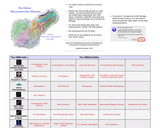
The Online Macromolecular Museum (OMM) is a site for the display and study of macromolecules. Macromolecular structures, as discovered by crystallographic or NMR methods, are scientific objects in much the same sense as fossil bones or dried specimens: they can be archived, studied, and displayed in aesthetically pleasing, educational exhibits. Hence, a museum seems an appropriate designation for the collection of displays that we are assembling. The OMM's exhibits are interactive tutorials on individual molecules in which hypertextual explanations of important biochemical features are linked to illustrative renderings of the molecule at hand.
Why devote a site to detailed visualizations of different macromolecules? In learning about the intricacies of life processes at the molecular level, it is important to understand how natural selection has fashioned the structure and chemistry of macromolecular machines to suit them for particular functions. This understanding is greatly facilitated by the visualization of 3-dimensional structure, when known. So, if static views of molecules (even in stereo) are worth a thousand words, then interactive animations of molecules should be worth much more. Indeed, we have found the types of displays represented here invaluable in gaining an appreciation for the details of key biochemical processes.
As Carl Brandon and John Tooze stated in their classic text, Introduction to Protein Structure:
"Molecular biology began some 40 years ago with the realization that structure was crucial for a proper understanding of function. Paradoxically, the dazzling achievements of molecular genetics and biochemistry led to the eclipse of structural studies. We believe the wheel has now come full circle, and those very achievements have increased the need for structural analysis at the same time that they have provided the means for it."
It is our opinion that structural analysis should extend into the classroom: as students learn about cellular mechanisms it is important that they study the chemistry of the molecular machines involved. These considerations have motivated the construction of the OMM.
The OMM is part of a collaborative effort by faculty and students interested in macromolecular structure-function relationships. The primary authors of some tutorials are students of David Marcey and he serves as author, co-author and site editor, and assumes all responsibility for content. Any criticisms, suggestions, comments, or questions should be sent to him at: marcey@callutheran.edu. All tutorials are copyrighted.
The OMM was started in 1996 for a Molecular Biology class at Kenyon College, where DM was a professor in the Biology Department (1990-1999). The OMM is now developed and housed at California Lutheran University, where DM has been a professor since 1999.

This resource is a video abstract of a research paper created by Research Square on behalf of its authors. It provides a synopsis that's easy to understand, and can be used to introduce the topics it covers to students, researchers, and the general public. The video's transcript is also provided in full, with a portion provided below for preview:
"The composition of our gut microbial community has been linked directly to our health, but researchers are only beginning to study the impact of its functional metabolic behavior, which can shift in response to external factors. Microbial production of H₂S in the gut is one such function, and it may be a colorectal cancer trigger. A recent study used publicly available datasets to examine the sulfur metabolism genes in our gut microbiota. Sulfur metabolism genes were more abundant and diverse than previously thought and were correlated with colorectal cancer. The researchers also examined two key sulfate reductases: dissimilatory sulfite reductases (Dsr) and anaerobic sulfite reductase (asr) and found that genes for asr were twice as abundant as genes for Dsr, suggesting that asr is a more important contributor to sulfate reduction in the human gut and found that genes for asr were twice as abundant as genes for Dsr, suggesting that asr is a more important contributor to sulfate reduction in the human gut..."
The rest of the transcript, along with a link to the research itself, is available on the resource itself.

Dr. Bolander recently retired from the University of South Carolina, where he taught biochemistry at both the graduate and undergraduate levels for decades. He accumulated considerable figures and notes and is making them available to others involved with teaching biochemistry or related courses.
These notes cover material with weaker coverage in standard biochemistry textbooks. This text is supplemental rather than primary.

This 12 session course is designed for the beginning or novice weight lifter, or for those who have experience lifting but lack proper instruction. We will provide an understanding of the biomechanics involved, muscles used for a given exercise, and program development.